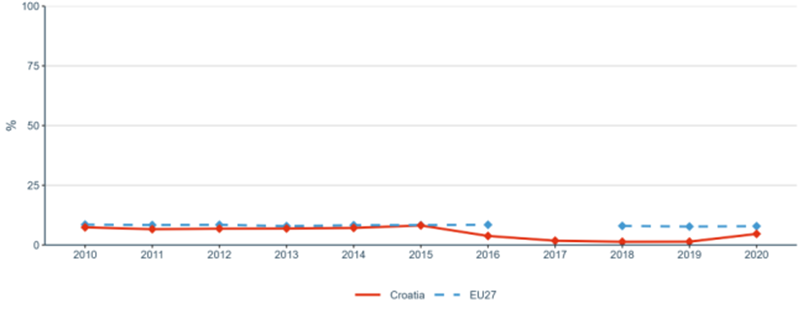ERA Country Report 2023
Croatia
Edited by Domagoj Racic (Independent Science, Technology and Innovation policy expert)
as part of ‘Development of the ERA Scoreboard, the ERA Dashboard and the Regular Reports’ project for the European Commission, Directorate-General for Research and Innovation under Framework Contract N° 2018/RTD/A2/OP/PP-07001-2018 Lot 2 (EDAR)
Click here to download this country report![]()
- Table of contents
-
ERA Country Report 2023: Iceland
1. National context
1.1. Overview of the ERA policy agenda implementation
1.2. Policy context
2. Assessment of the Implementation of the ERA Policy Agenda and ERA Priorities
2.1. ERA Priority 1: Deepening a truly functional internal market for knowledge
2.2. ERA Priority 2: Taking up together the challenges posed by the twin green and digital transition and increasing society’s participation in the ERA
2.3. ERA Priority 3: Amplifying access to research and innovation excellence across the Union
2.4. ERA Priority 4: Advancing concerted research and innovation investments and reforms
3. Country-specific drivers and barriers
4. Final remarks
5. Bibliography
6. Annexes
6.1. Annex 1: Graphs
|
Key takeaways:
|
1. National context
1.1. Overview of the ERA policy agenda implementation
According to the European Innovation Scoreboard (EIS) 2023, Croatia is an Emerging Innovator with performance at 69.6% of the EU-27 average. Its performance is improving at a rate higher than that of the EU-27 average (8.5 percentage points) and is above the average of the Emerging Innovators.
According to the EIS, Croatia’s relative strengths are in public-private co-publications, people with above basic overall digital skills, product innovators, business process innovators and venture capital expenditures. Relative weaknesses include lifelong learning, innovation expenditures per employee, environment-related technologies, knowledge-intensive services exports, and design applications.
Croatia has committed to seven ERA Actions within Priority Areas 1 (Deepening a truly functioning internal market for knowledge) and 3 (Amplifying access to research and innovation excellence across the Union). These commitments are predominantly addressed through overall R&I system reforms and investments which are undertaken with the support of the Resilience and Recovery Facility and the European Structural and Investment Funds. The new laws have recently redefined the science and higher education landscape. The Act on Higher Education and Scientific Activity, adopted in October 2022, explicitly refers to ERA and implements the relevant commitments within its provisions, such as the emphasis on open science. The Act on Quality Assurance in Higher Education and Science, adopted in December 2022, explicitly refers to the European Higher Education Area (EHEA), but is also consistent with ERA-related actions.
1.2. Policy context
Key decisions related to R&I policies are taken at the national level through several actors. The Ministry of Science and Education is responsible for the development of the education system, including lifelong learning and vocational education and training, and for the development of science. The Ministry of Economy and Sustainable Development is responsible for fostering competitiveness of the economy, promote entrepreneurship and industrial policies, as well as the policy regarding the application of innovation and new technologies.
Moreover, the Ministry of Regional Development and EU Investment Funds is the Managing Authority for the Programme Competitiveness and Cohesion through which European Regional Development Fund (ERDF) resources are allocated. Similarly, the Croatian Science Foundation provides financing for fundamental and applied research, and the Agency for Science and Higher Education is a public agency in charge of quality assurance in the sectors of science and higher education. In addition, the Croatian Agency for SMEs, Innovation and Investments (HAMAG-BICRO) provides innovation support to companies and entrepreneurs.
There are national strategies and policy documents that contribute to the implementation of the ERA policy agenda. The National Development Strategy (NDS) of the Republic of Croatia until 2030 was adopted in 2021. It determines the overall development framework at the national level. The Smart Specialisation Strategy until 2029 was adopted at the end of 2023. Additionally, the Research infrastructures roadmap 2023 - 2027 was adopted in June 2023.
The national Recovery and Resilience Plan - RRP has been the crucial policy document influencing reforms and investments and setting the overall pace of socio-economic development in recent years. One of the priorities is boosting the economic recovery by leveraging private investment, lifting regulatory and administrative constraints, accelerating the development of the green and digital economies and incentivising research, development and innovation. That includes streamlining the fragmented R&I system (currently numbering 445 organisations), which should contribute to improving its performance and spending efficiency and facilitating science-industry collaboration.^
Based on the Partnership Agreement with the European Commission, in the period 2021-2027 Croatia will implement the Programme for Competitiveness and Cohesion, the Integrated Territorial Programme and the Efficient Human Resources Programme, which will also affect the ERA policy agenda. Additional resources and technical assistance for the transformation of the R&I system in the context of green and digital transition will be provided through the DIG-IT project, funded by the World Bank.
The adoption of new legislation in accordance with the RRP, such as the Act on Croatian Science Foundation, the Act on Higher Education and Scientific Activity and the Act on Quality Assurance in Higher Education and Science, has led to noticeable improvements in the R&I context^. These acts have regulated the implementation and management of programmes related to research and innovation, aiming to promote excellence and efficiency. Performance-based funding of Higher Education Institutions (HEIs) and Public Research Institutes (PROs) follow this new legislation supported by the ordinance adopted by the government of Croatia in July 2023, providing additional incentives for excellence.
Rules on the conditions for selection in scientific professions have also been revised. The opportunities for more flexible employment in public research and higher education organisations have been opened, whereas the career advancement criteria are now stricter. Investment in C3.2 R2-I1 within the RRP is the development of an enabling model for researchers’ career progression and conducting cutting-edge scientific research in STEM and ICT fields.
2. Assessment of the Implementation of the ERA Policy Agenda and ERA Priorities
This chapter has two objectives: 1) It qualitatively assesses the state-of-play of the implementation of the ERA actions that Croatia has committed to. The qualitative information stems from the OECD STIP survey 2023 and additional desk research on the national institutions and initiatives that the country has carried out in relation to the ERA Policy Agenda; 2) It quantitatively assesses the country’s progress towards achieving the ERA priorities as set out in the Pact for Research and Innovation in Europe. The presented quantitative information is mainly based on the ERA Scoreboard and ERA Dashboard indicators and covers longer-term trends since 2010. Additionally, general indicators for the overall R&I system are outlined in Table 1. More detailed information on the data and graphs can be found in Annex 1.
| Indicator |
Most recent EU average |
Most Recent Metric |
| Gross Domestic Expenditure on R&D (GERD) as a percentage of GDP |
2.26 (2021) |
1.24 (2021) |
| Government Budget Allocations for R&D (GBARD) as a share of GDP |
0.76 (2021) |
0.71 (2021) |
| Researchers (in full-time equivalent) per million inhabitants |
4,483.4 (2021) |
2,355.6 (2021) |
| Business Enterprise expenditure on R&D (BERD) as a percentage of GDP |
1.49 (2021) |
0.6 (2021) |
Source: compiled by research team based on the ERA Scoreboard and ERA Dashboard indicators
2.1. ERA Priority 1: Deepening a truly functional internal market for knowledge
2.1.1. State of play in the implementation of the ERA Actions
As for ERA Action 1: Enable Open Science, including through the European Open Science Cloud (EOSC), the Croatian Declaration on Open Access to Scientific Information was adopted in 2012, but earlier initiatives such as the Croatian Scientific Bibliography, date back to 1997. CroRIS (Croatian Research Information System) promotes open science by enabling visibility, transparency and public availability of research projects and achieved results. Croatia has developed the national e-infrastructure through the Croatian scientific and educational cloud (HR-ZOO) project and has also actively participated in the European Open Science Cloud Association (EOSC) since 2020. Croatian Open Science Cloud Initiative (HR-OOZ) is a multi-stakeholder aiming to establish a national organisational and technology framework for open science. Similarly, the Hrčak open access, a database where all Croatian scientific journals are published and freely available. Furthermore, adoption of the National Action Plan for Open Science is planned for 2024. Since 2021, the Croatian Science Foundation (CSF) introduced research data management plans as a required element for any research project financed by CSF.
Advancement towards ERA Action 3: Reform the Assessment System for research, researchers and institutions was made in 2022, when modernisation of the legal framework regulating science and higher education was undertaken through the adoption of the aforementioned Act on Croatian Science Foundation, Act on Higher Education and Scientific Activity and the Act on Quality Assurance in Higher Education and Science. In this sense, the RRP C3.2. R1 focuses on the “Reform and strengthening of the research and development capacities of the public research sector”, highlighting the importance of research to promote R&I and prepare for future challenges.^ Quality improvements are a prerequisite to further develop assessment criteria and practices in line with ERA action 3, which envisages, for instance, rewarding open science practices in terms of open collaboration and early knowledge and data sharing.
As for ERA Action 4: Promote attractive research careers, talent circulation and mobility, the Law on Strategic Planning and Development Management NN 123/2017 defined the development of the National Development Strategy of the Republic of Croatia until 2030. It aims to work as a guide for researchers in the area of development and innovation related policies. Croatia is also engaged with EURAXESS, and the Service Centre and local contact points work to assist mobility and encourage international research. Croatia has been encouraging and supporting academic mobility, but the results have been mixed and currently the country is last in the EU ranking of mobility of researchers after they obtain their PhD. In addition, the Programme Competitiveness and Cohesion 2021-2027 aims, under objective RSO1.4, to promote PhD students in the areas of STEM mobility and placements through financing programmes in R&I.
In the case of ERA Action 5: Promote gender equality and foster inclusiveness, the promotion of (gender and other) equality and equal opportunities is a horizontal priority within the National Development Strategy until 2030. This action is also covered under the Recovery and Resilience Plan (RRP), that promotes the strengthening of gender equity and balance both in terms of representation and training. Gender equality and non-discrimination are embedded in the relevant legislation and practised within the R&I system. In 2021, Croatia signed the Ljubljana Declaration on Gender Equality in Research and Innovation. The Ministry of Science and Education is an associated partner within the GENDERACTIONplus project (funded by Horizon Europe), whose overall goal is to contribute to advancing gender equality in the ERA through capacity building, policy exchange and coordination, as well as the provision of strategic policy advice.
When it comes to ERA Action 7: Upgrade EU guidance for a better knowledge valorisation, concerns related to knowledge valorisation have been addressed throughout major R&I policy documents and funding mechanisms. The Draft for the Smart Specialisation Strategy 2029 defends the importance of shifting knowledge towards the market, appealing to the importance of the internationalisation of knowledge, specially of the IT sector. In particular, in 2022, the Ministry of Science and Education developed National Technology and Knowledge Transfer Guidelines. The calls for project proposals focusing on proof-of-concept and support to technology transfer were subsequently launched. The Horizon Europe Policy Support Facility was also sought to support early stages of innovation and science-business linkages in Croatia, which resulted in recommendations to systematically implement knowledge valorisation concerns in research projects and academic institutions. Furthermore, the Programme Competitiveness and Cohesion 2021-2027 encourages national knowledge recognition through the Scientific Centres of Excellence (ZCI) in the country that contribute to smart specialisation through the development of innovative technologies.
2.1.2. Progress towards achieving ERA Priorities
Within the Sub-priority 1.1: Open science, when it comes to the percentage of open access scientific publications in total scientific publications, Croatia consistently exceeds the EU-27 average, as over 50% of publications (50.67 % in 2019) are available in open access. The EU-27 average in 2019 was 39.17% (Figure 5 in Annex 1).
As for the Sub-priority 1.2: Research infrastructures, Croatia participates in in eight European Research Infrastructure Consortia (ERICs) as of December 2023, and in six ESFRI Projects and Landmarks, whereas the EU-27 average is sixteen European research infrastructures (Figure 6 in Annex 1).
Regarding Sub-priority1.3: Gender equality, equal opportunities for all and inclusiveness, Croatia performs well. As it can be observed in Figure 7 in Annex 1, the proportion of women among doctoral graduates in STEM in the EU-27 is fairly stable (37%-38%) and lags behind Croatia (48% in 2020). Until 2018, when the data series ends, the ratio of women in grade A positionsin higher education institutes (about a third) in Croatia was consistently higher than the EU-27 average (also Figure 7 in Annex 1).
The proportion (%) of women among doctoral graduates by narrow fields of Science, Technology, Engineering and Mathematics (STEM) in Figure 8 in Annex 1 shows that Croatia follows the same trend as the EU-27 average, with the exception of 2014 when Croatia drops slightly, with the country being over the EU-27 average. Moreover, the proportion of papers with mixed gender authorship is increasing (from 51.7% in 2016 to 56.2% in 2020), but the gap in comparison to the EU-27 average (62.7% in 2020) is gradually widening (Figure 9 in Annex 1). Figure 10 shows that, until 2018, when the data series ends, the proportion of women in authorships of the 10% most cited publications in Croatia was consistently higher than the EU-27 average (42.4% in 2018, compared to 32.6% in the EU-27 as a whole). Figure 11 in Annex 1 shows that the Women in Digital Index in 2022 was slightly higher in Croatia (56) than the EU-27 average (55).
In Sub-priority1.4: Researchers’ careers and mobility and research assessment and reward systems, the trends in Croatia are mostly stable. The number of new doctorate graduates (25-34) per 1,000 inhabitants oscillates around 0.5, which means that the gap in comparison to the EU-27 (which oscillates around 0.8) is also stable (Figure 13 in Annex 1).
The proportion of foreign doctorate students as a percentage of all doctorate students increased from 3.2 in 2015 to 8.2 in 2020, which indicates the effects of EU membership and stronger integration of Croatia into the ERA (Figure 12 in Annex 1). However, this level of internationalisation lags significantly behind the EU-27 average whose performance is also improving (from 16.3 in 2015 to 23.3 in 2020). Job-to-job mobility of Human Resources in Science & Technology shows a rare example of Croatia being able to close the gap in comparison to the EU-27 average after its EU accession (Figure 14 in Annex 1). In 2013, the lag was considerable (2.9 vs. 5.4), whereas in 2020 Croatia exceeded the EU-27 average (6.9 vs 6.8).
When it comes to Sub-priority 1.5: Knowledge valorisation, the share of public-private co-publication per million population, Croatia’s performance surpassed the EU-27 average in 2016 and has remained above the average over time (189 vs. 134 co-publications in 2021) (Figure 15 in Annex 1). On the other hand, the number of PCT patent applications divided by GDP in million euros, which was recorded until 2015, was persistently low and stagnant (Figure 16 in Annex 1). The share of innovating firms collaborating with HEIs/PROs out of all innovative firms reached 10.64% in 2016 (when ESIF-funded science-industry collaboration projects were already introduced) and has remained at the same level ever since (10.23% in 2020). The EU-27 average in 2020 was 13.27% (Figure 17 in Annex 1).
Two Croatian best practice examples in the area of knowledge valorisation have been identified. “Be the Role Model” is an educational programme in entrepreneurship developed at the University of Osijek, and was designed to provide theoretical knowledge, mentoring, software support and hands-on experience in creating and presenting innovations and business plans (in Croatian, English and Hungarian). RIMAP (Regional Innovation Matchmaking Programme) is an online innovation platform for knowledge transfer between academia, enterprises, the local government, and NGOs in Primorje - Gorski Kotar County of Croatia and beyond, aiming to foster an innovation ecosystem in the region.
In the area of Sub-priority 1.6: Scientific leadership the share of scientific publications among the top-10% most cited publications worldwide (Figure 18 in Annex 1) in all publications has improved after the EU accession of Croatia, from 2.9 in 2013 to 4.8 in 2020, whereas the EU-27 average has been stagnant (9.8 in 2020). The Academic Freedom Index is high, but slowly decreasing in both Croatia and the EU-27 (Figure 19 in Annex 1).
Sub-priority 1.7: Global engagement is examined through the number of international co-publications with non-EU partners per 1,000 researchers (Figure 20 in Annex 1), which has been growing consistently in Croatia. The EU-27 average has continued to increase in comparison to the Croatian data (1009 in 2021). European and international co-patenting in EPO applications at national and EU level is consistently lower in the country than in the EU-27. Both trends remain stagnant from 2010 to 2012, when the EU-27 drops (Figure 21 in Annex 1).
2.2. ERA Priority 2: Taking up together the challenges posed by the twin green and digital transition and increasing society’s participation in the ERA
2.2.1. State of play in the implementation of the ERA Actions
Despite the lack of commitment from Croatia to the actions under ERA Priority 2, the country has adopted at the national level specific initiatives that are aligned with it. More specifically, and in relation to ERA Action 10: Make EU research and innovation missions and partnerships key contributors to the ERA, Croatia has two experts in the EU Missions Boards that aim to increase awareness and promote innovation in the societal scope.
The relevance of the climate transition for the development of the country, is reflected through national plans aligned with ERA Action 11: An ERA for green transformation. The Low-carbon Development Strategy of the Republic of Croatia aims to reduce greenhouse gras emission while promoting sustainable energy. Similarly, the Integrated National Energy and Climate Plan of the Republic of Croatia for 2021 to 2030 (NECP) is developed towards climate neutrality, energy efficiency and security. The Ministry of Science and Education developed the Digital, Innovation and Green Technology Project (DIGIT) to strengthen R&I through enhancing the green and digital transition. Focusing on accelerating the economic adaptability, the project aims to improve the institutional and legislative context as well as promoting better research infrastructure and higher levels of financing. In this sense, DIGIT collaborates in the efforts towards ERA Action 11 and ERA Action 12: Accelerate the green/digital transition of Europe’s key industrial ecosystems.
In 2022, new initiatives surrounding ERA Action 13: Empower Higher Education Institutions were developed. The Act on Higher Education and Scientific Activity and the Act on Quality Assurance in Higher Education and Science provides a new scope in the academic area, promoting more flexibility and advancement in the R&I framework. In relation to this, the CeOS_SE project is aligned with ERA Action 14: Bring Science closer to citizens as it aims to increase engagement with Science in Southeastern European Countries through awareness raising.
2.2.2.Progress towards achieving ERA Priorities
With regard to progress towards the Sub-priority 2.1: Challenge-based ERA actions, the indicator Government budget allocations for R&D (GBARD) by NABS in energy; environment; transport, and telecommunications and other infrastructure shows that Croatia has emphasised the area of Environment where it regularly exceeds the EU-27 average (EUR 4,381 million vs. EUR 106 million in 2021), whereas its performance in Energy and Transport, telecommunications and other infrastructure is very weak (Figure 22 in Annex 1).
For GBARD allocated to Europe-wide transnational public R&D programmes per FTE researcher (Figure 23 in Annex 1), both the EU-27 and Croatia display performance variations, but Croatia consistently lags behind the EU-27 average (EUR 850 vs. EUR 1,789 in 2021). As seen in Figure 24 in the Annex, the Croatian data for National public and private investments as suggested in the SET Plan progress report 2021 remains lower than the European average during the whole period. Despite the allocation of GBARD into the area of environment, the indicator OECD Patents on environment technologies for Croatia shows deterioration from 10.9 in 2017 to 2.7 in 2019, whereas EU-27 average oscillates around 13 (Figure 25 in Annex 1).
In the case of Sub-priority 2.2: Synergies with education and the European Skills Agenda, the share of researchers receiving transferable skills training was measured in 2016 and 2019; in both instances the indicator for Croatia surpassed that of the EU. In 2019, 54.2% of researchers in Croatia received such training, whereas the EU-27 average was 46.3% (Figure 26 in Annex 1).
Sub-priority 2.3: Synergies with sectorial policies and industrial policy in order to boost innovation ecosystems is examined through the direct and indirect government support through R&D tax incentives as a percentage of GDP. Its value was very high in Croatia until 2014 (0.25%), but it then fell to almost zero. This could be associated to the lack of legal framework for tax incentives, as when such framework was reintroduced in 2019, it rose to 0.11% in 2020. The EU-27 average has grown slowly and reached 0.18% in 2020 (Figure 27 in Annex 1).
In relation to Sub-priority 2.4: An active citizen and societal engagement in R&I in all its dimensions, its indicator of trust in science in 2021 was almost the same in Croatia (42.6%) as in the EU-27 as a whole (43.2%), indicating the widespread need to engage with citizens more effectively (Figure 28 in Annex 1). On the other hand, research on social innovation is growing, with Croatia being among the leaders. The number of publications on 'social innovation' or 'social entrepreneurship' per million population in Croatia increased from 1.9 in 2014 to 7.7 in 2021; whereas the EU-27 average grew from 0.9 in 2014 to 1.8 in 2021 (Figure 29 in Annex 1).
2.3. ERA Priority 3: Amplifying access to research and innovation excellence across the Union
2.3.1. State of play in the implementation of the ERA Actions
In the Croatian context, ERA Action 16: Improve EU-wide access to excellence primarily means more participation in the EU programmes that support research and innovation. Since 2018, Croatia has been supporting national participation in EU programmes for research, innovation and space, through different support measures. In 2021, the Ministry of Science and Education has developed and adopted the guidelines for the national support system of Horizon Europe, in which organisation of the support system, communication activities, as well as the roles and responsibilities of different stakeholders are outlined. Financial support is provided to project proposal development, as well as to the projects that passed the evaluation threshold but did not receive funding. The programmes covered by the financial support measures are Horizon Europe, Euratom Research and Training Programme, EU Space Programme and European Space Agency calls for proposals.
Moreover, the National Development Strategy of the Republic of Croatia highlights the importance of cooperation for development, stating that global governance is key for economic growth in the green and digital transition. This demonstrates the country´s commitment to international collaboration and European initiatives.
In relation to ERA Action 17: Enhance public research institutions’ strategic capacity, the RRP presents in section C.3.2 R1 a programme to increase the investment for Universities and HEIs´ scientific research. It appeals to the importance the entities have to boost quality and importance both at a national and international level. In this sense, the RRP defends that it is necessary to diminish the fragmentation of the research system and that new agreements on the funding and capacity of the research institutions will strengthen the institutional R&I competences.
Additionally, R&I managers are still not recognised as a profession (or a set of professions) with specific knowledge, skills and competencies in Croatia. However, some specific functions such as experts for proposal writing, financial reporting and procurement experts and knowledge/technology transfer officers are gradually (and mostly informally) gaining prominence, as R&I project development and management knowledge and experience are accumulated in the Croatian R&I organisations in public and private sectors. Croatia participate in the EU-funded “RM Roadmap” project, which “will create a roadmap for the future of research management (RM) in Europe and a community to support its deliver”.
Research infrastructure projects financed through ESI Funds are obliged to include organisational reform of the host organisation (which will own and operate the research infrastructure), but it may be necessary to undertake additional capacity building which will facilitate internationalisation of R&I activities and facilitate efficient and impactful utilisation of research infrastructures in Croatia. This is supported by the Research Infrastructures Roadmap of the Republic of Croatia 2023-2027, that involves a long-term plan to improve the quality and build capacity of research infrastructures in Croatia. The roadmap also encourages the sustainability and resilience of public research institutions, appealing to the importance of synergies between the international and national partners to maximise effects.
2.3.2. Progress towards achieving ERA Priorities
With regard to progress towards the Sub-priority 3.1: More investments and reforms in countries and regions with lower R&I performance, the relevant indicator is the increase (in percentage points) of total R&D expenditure expressed as a percentage of GDP (Figure 30 in Annex 1). Croatia has performed well since 2017, primarily due to ESIF-funded R&I projects and has exceeded the EU-27 average in all years since 2018.
2.4. ERA Priority 4: Advancing concerted research and innovation investments and reforms
2.4.1. State of play in the implementation of the ERA Actions
Within the Sub-priority 4.1: Coordination of R&I investments, the key indicator is the share of public R&D expenditures financed by the private sector (Figure 31 in Annex 1). In 2015, the share of public R&D expenditures financed by the private sector in Croatia and the EU-27 as a whole was almost the same (around 8%). Following this, the EU-27 average remained stable during the period. However, Croatia experienced some fluctuations, until registering a value of 4.6% in 2020. The reintroduction of tax incentives, based on the Act on State Aid for Research & Development Projects adopted in July 2018, is supposed to further contribute to increases concerning this indicator.
3. Country-specific drivers and barriers
The main driver which supports reforms and investments in the R&I system in Croatia is the Europeanisation of its R&I policy. This driver primarily stems from the implementation of the RRP for Croatia, which is complemented and enhanced by the interventions and funding obtained through ESIF and the national budget.
Additionally, key policy priorities have been set in a dialogue with the European Commission, and further developed through policy dialogue at the national level. This dialogue has been evidenced in the implementation of the new smart specialisation strategy through methods such as the Thematic Innovation Councils which offer a new communication instrument in the country. The current reforms initiated in 2022 have been successful in overcoming the policy inertia which has often characterised R&I policy in Croatia after its EU accession in 2013.^ Focus on the absorption of ESIF has led to the focus on implementation governance and the related structure and processes, with policy governance and policy learning being given much less prominence, which was particularly discernible in the case of smart specialisation strategy.^
R&I performers have also often focused on ESIF project funding and somewhat less on internationalisation of their research and innovation activities within the ERA. However, the lack of the strategic approach to ESIF projects may have also reduced their impacts. Consequently, even though the country recognises the importance of these areas, the R&I ecosystem suffers from various shortcomings such as fragmentation, insufficient collaboration and weak orientation towards excellence.
Implementation of the current reforms in such an environment is likely to be complex and challenging, as R&I system encompasses a variety of autonomous public and private actors with different strategies, interests, and capacities.
4. Final remarks
Croatia has already implemented new national initiatives aligned with the ERA Priorities, demonstrating its engagement with the ERA Policy Agenda. Currently, the country has committed to seven ERA Actions in Priority Areas 1 (Deepening a truly functioning internal market for knowledge) and 3 (Amplifying access to research and innovation excellence across the Union). Based on the analysis conducted, Croatia performs noticeably well in open science, gender equality and public-private co-publications, whereas other targeted areas require additional efforts.
Within Priority Area 1, the current R&I system reform is focused on improving assessment, attractiveness of research careers and knowledge valorisation. Regarding Priority Area 3, Croatia aims to improve access to R&I excellence and enhance the strategic capacity of research performers. Key reform initiatives in these areas, include the adoption of the Act on Higher Education and Scientific Activity and the Act on Quality Assurance in Higher Education and Science, development of an incentive model for advancing researchers' careers, reforms of performance-based funding and streamlining of management, and implementation of R&I funding programmes.
Strong incentives and funding mechanisms, including performance agreements, competitive research grants, innovation finance and additional funding for governance reforms, collaboration and internationalisation can lead towards R&I excellence and better integration into the ERA.^
1 Račić, D. and Cvijanović, V. (2022). Support to early stages of innovation and science - business linkages in Croatia: Background report. Luxembourg: Publications Office of the European Union.
5. Bibliography
Act on Higher Education and Scientific Activity (Zakon o visokom obrazovanju i znanstvenoj djelatnosti), NN 119/2022, 19 October 2022. Available at: https://narodne-novine.nn.hr/clanci/sluzbeni/2022_10_119_1834_html
Act on Quality Assurance in Higher Education and Science (Zakon o osiguravanju kvalitete u visokom obrazovanju i znanosti), NN 151/2022, 22 December 2022. Available at: https://narodne-novine.nn.hr/clanci/sluzbeni/2022_12_151_2330.html
Act on State Aid for Research & Development Projects (Zakon o državnoj potpori za istraživačko-razvojne projekte), NN 64/18, 18 July 2018. Available at: https://narodne-novine.nn.hr/clanci/sluzbeni/2018_07_64_1306.html
CEU (2021). ANNEX to the Council Implementing Decision on the approval of the assessment of the recovery and resilience plan for Croatia. Brussels: Council of the European Union.
EC (2021). Analysis of the recovery and resilience plan of Croatia. SWD(2021) 197 final. Brussels: European Commission. Available at: https://eur-lex.europa.eu/legal-content/EN/TXT/PDF/?uri=CELEX:52021SC0197.
EC (2023). European Innovation Scoreboard 2023 – Country profile Croatia. Brussels: European Commission. Available at: https://ec.europa.eu/assets/rtd/eis/2023/ec_rtd_eis-country-profile-hr.pdf.
EC (2023a). Commission staff working document: 2023 Country Report – Croatia. SWD(2023) 611 final. Brussels: European Commission. Available at: https://economy-finance.ec.europa.eu/system/files/2023-05/HR_SWD_2023_611_en.pdf.
Government of Croatia (2021). National Development Strategy of the Republic of Croatia until 2030 (Nacionalna razvojna strategija Republike Hrvatske do 2030. godine). Available at: https://hrvatska2030.hr/wp-content/uploads/2021/02/Nacionalna-razvojna-strategija-RH-do-2030.-godine.pdf.
Government of Croatia (2021a). Recovery and Resilience Plan (Plan oporavka i otpornosti). Zagreb: Government of Croatia. Available at: https://planoporavka.gov.hr/dokumenti-113/113
Integrated Territorial Programme 2021 – 2027. Available at: https://strukturnifondovi.hr/wp-content/uploads/2022/12/ITP-odobreni.pdf
MSE (2022). National Technology and Knowledge Transfer Guidelines (Nacionalne smjernice za transfer tehnologije I znanja) Zagreb: Ministry of Science and Education. Available at: https://mzo.gov.hr/UserDocsImages//dokumenti/Znanost/TransferTehnologije//Nacionalne-smjernice-za-razvoj-tehnologije.pdf
MSE (2023). Research Infrastructures Roadmap of the Republic of Croatia 2023 - 2027. (Plan razvoja istraživačke infrastrukture u Republici Hrvatskoj 2023. - 2027.) Zagreb: Ministry of Science and Education. Available at: https://mzo.gov.hr/...f
Närfelt, K.N, Cowey, L., Järvelin, A.-M., Pietras, M. and Wostner, P. (2023). Support to early stages of innovation and science - business linkages in Croatia. Independent expert report. Horizon Europe Policy Support Facility. Luxembourg: Publications Office of the European Union.
Programme Competitiveness and Cohesion 2021 – 2027. Available at: https://strukturnifondovi.hr/wp-content/uploads/2022/11/PKK-2021-2027.pdf
Programme Efficient Human Resources 2021 – 2027. Available at: https://strukturnifondovi.hr/wp-content/uploads/2022/11/Program-Ucinkoviti-ljudski-potencijali-2021.-2027_.pdf
Račić, D., Švarc, J. and Testa, G, (2018). RIO Country Report 2017: Croatia, EUR 29155 EN, Luxembourg: Publications Office of the European Union.
Račić, D. and Cvijanović, V. (2022). Support to early stages of innovation and science – business linkages in Croatia: Background report. Luxembourg: Publications Office of the European Union.
World Bank (2021). Analysis of Design and Implementation of Croatian S3 Governance. Zagreb: World Bank and Ministry of Science and Education. Available at: https://mzo.gov.hr/UserDocsImages/dokumenti/EUfondovi/OPKK_2014-2020/Pregled-javnih/Analiticki%20izvjestaj%204.2.%20komponente.pdf.
6. Annexes
6.1. Annex 1: Graphs
The 2023 ERA Scoreboard and ERA Dashboard indicators used in the country report are presented in this annex. Detailed information on the data sources, description of the indicators, time period for which the data is available, and the necessary calculations can be found in the ERA Scoreboard and ERA Dashboard Methodology Report. The most recent available data for each indicator has been used.
General Indicators
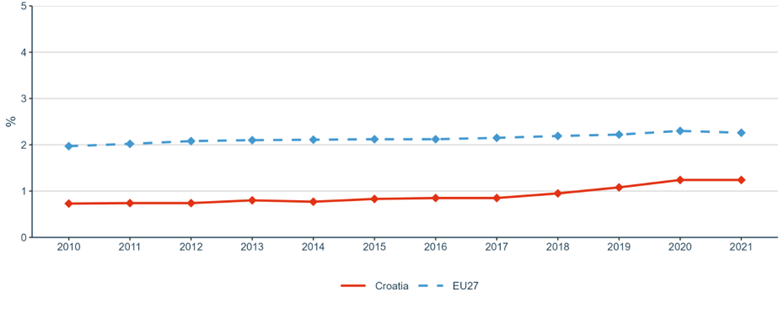


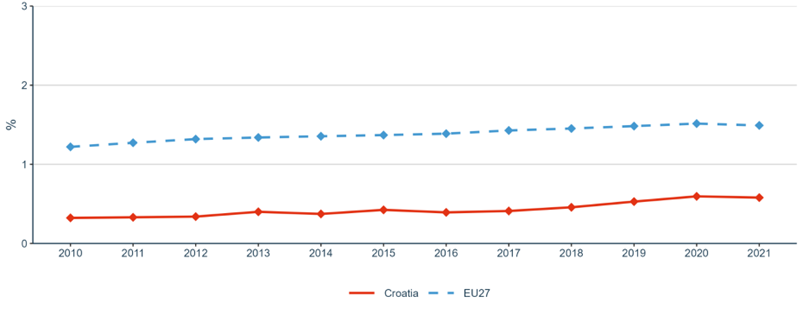
Priority 1: Deepening a truly functioning internal market for knowledge
Sub-priority 1.1: Open Science
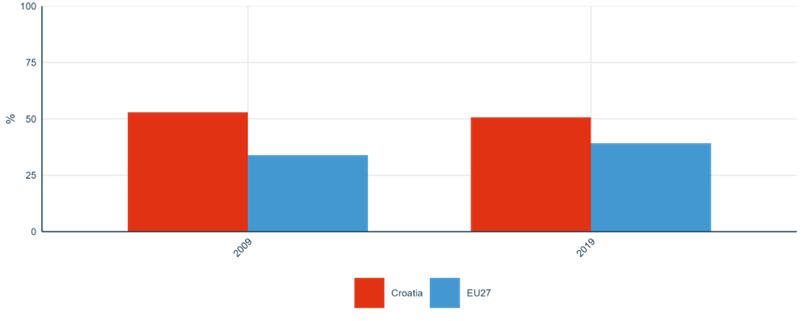
Sub-priority 1.2: Research infrastructures
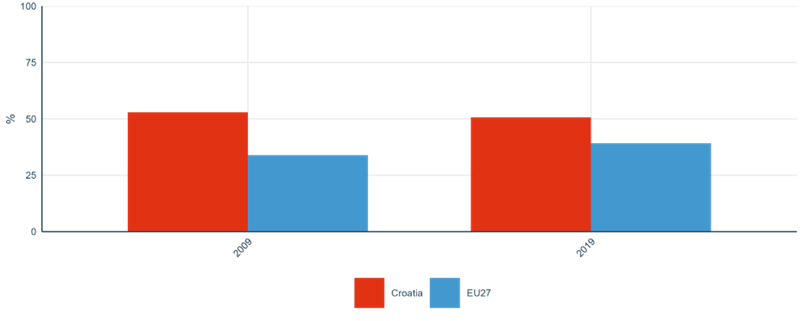
Sub-priority 1.3: Gender equality, equal opportunities for all and inclusiveness

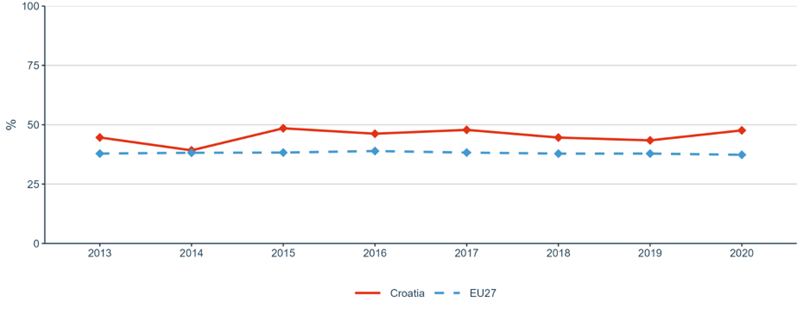

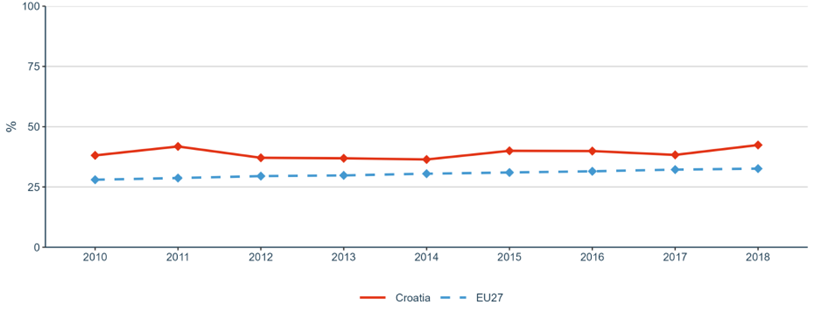

Sub-priority 1.4: Researchers’ careers and mobility and research assessment and reward systems
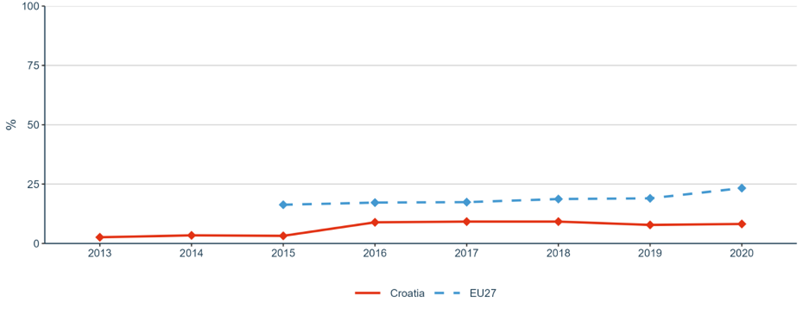

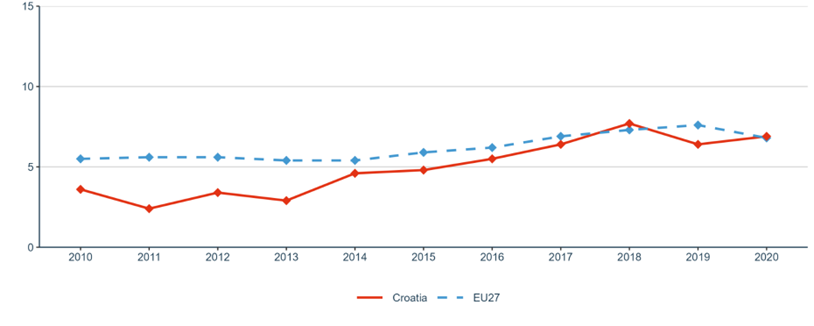
Sub-priority 1.5: Knowledge valorisation
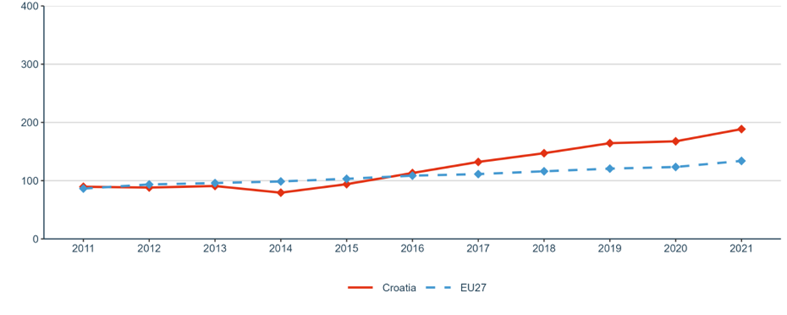
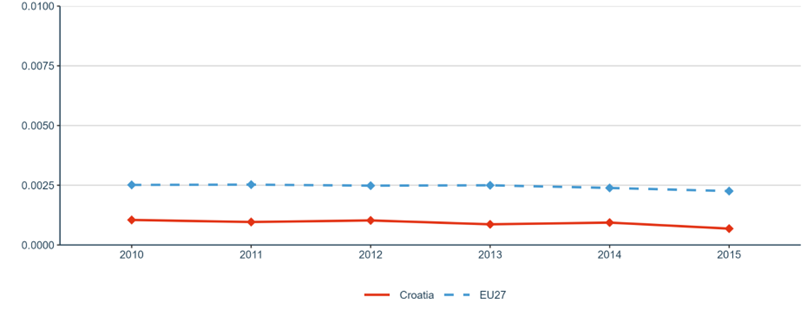

Sub-priority 1.6: Scientific leadership


Sub-priority 1.7: Global engagement
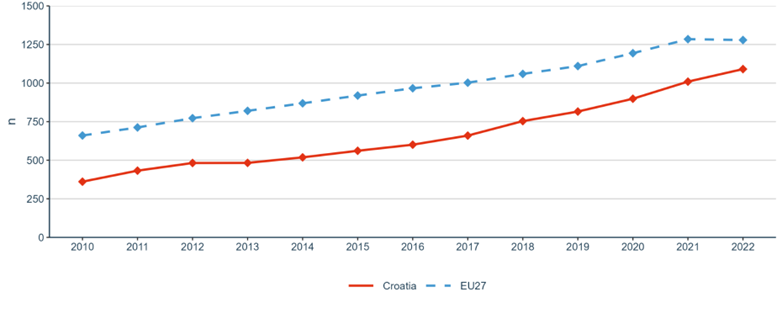

Priority 2: Taking up together the challenges posed by the twin green and digital transition, and increasing society’s participation in the ERA
Sub-priority 2.1: Challenge-based ERA actions
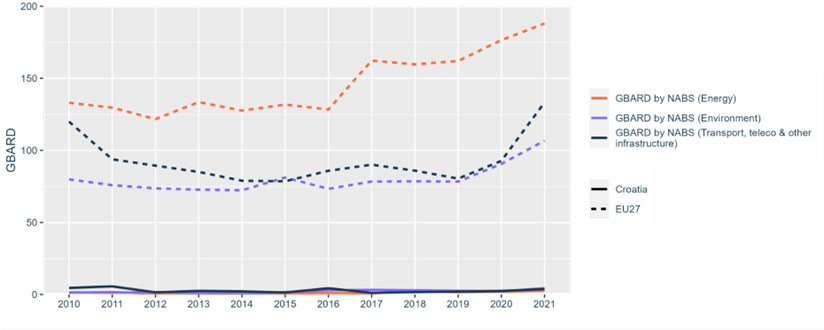


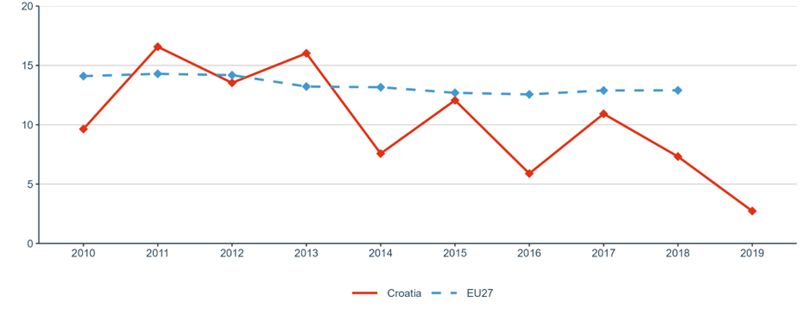
Sub-priority 2.2: Synergies with education and the European Skills Agenda

Sub-priority 2.3: Synergies with sectorial policies and industrial policy, in order to boost innovation ecosystems

Sub-priority 2.4: An active citizen and societal engagement in R&I in all its dimensions
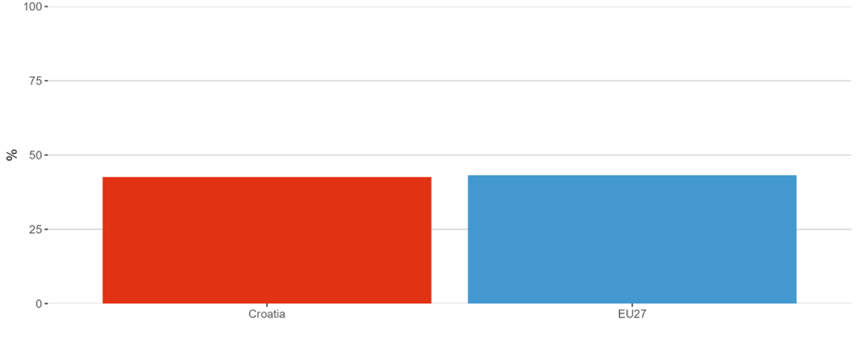
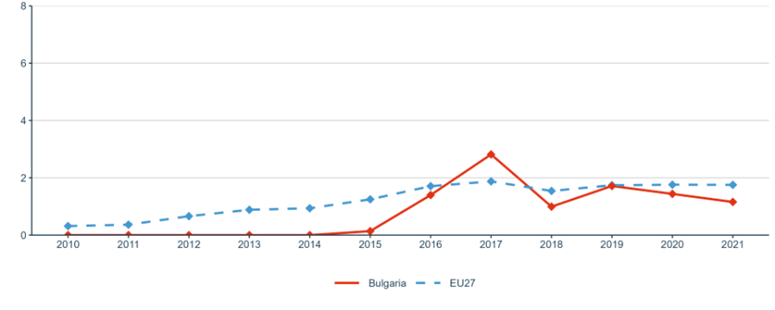
Priority 3: Amplifying access to research and innovation excellence across the Union
Sub-priority 3.1: More investments and reforms in countries and regions with lower R&I performance

Priority 4: Advancing concerted research and innovation investments and reforms
Sub-priority 4.1: Coordination of R&I investments
